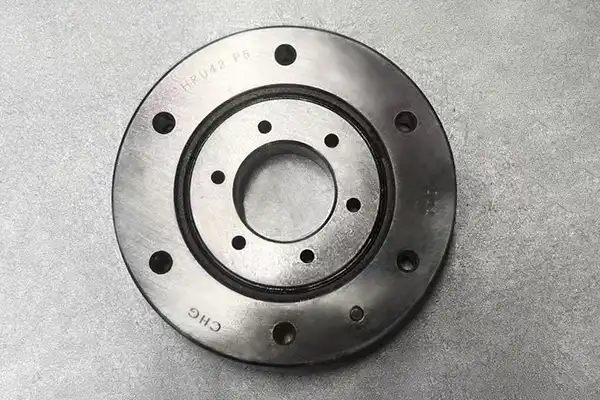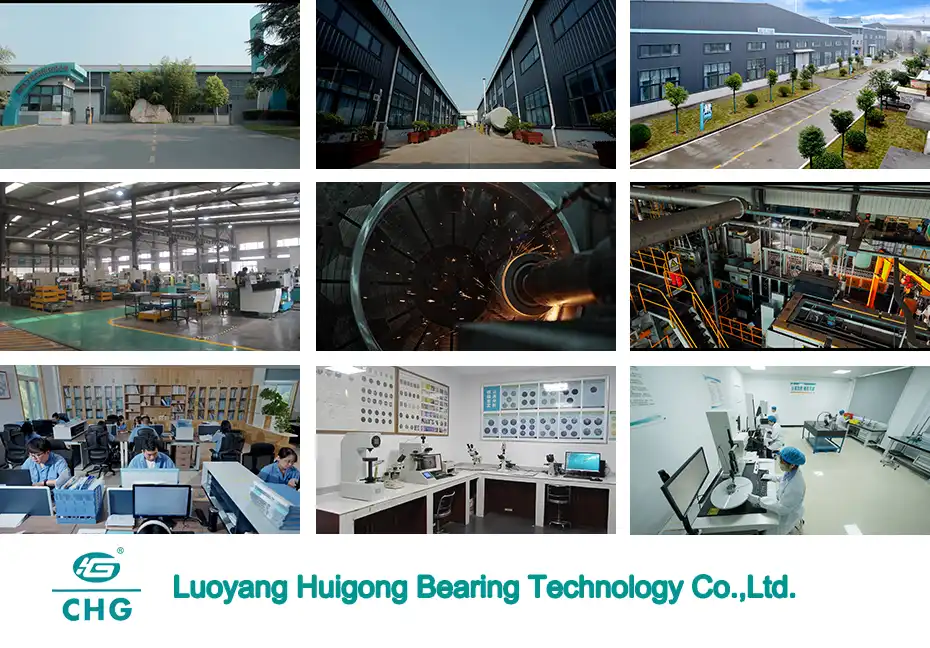How do RU Cross Roller Bearings Ensure Stable Rotation Accuracy in Demanding Applications?
In the world of precision engineering and industrial machinery, maintaining stable rotation accuracy is paramount for optimal performance. RU cross roller bearings have emerged as a critical component in achieving this goal, particularly in demanding applications where precision and reliability are non-negotiable. These specialized bearings incorporate alternating roller elements arranged at right angles to each other, creating a unique design that excels in handling complex loads while maintaining exceptional rotational accuracy. The implementation of these bearings has revolutionized various industries, from aerospace manufacturing to medical equipment, where precise motion control is essential for operational success.

What Makes RU Cross Roller Bearings Different from Traditional Ball Bearings?
RU cross roller bearings represent a significant advancement in bearing technology, distinguishing themselves from conventional ball bearings in several crucial ways. At their core, these bearings feature cylindrical rollers arranged in a perpendicular pattern, creating a cross-shaped configuration that provides superior load-bearing capabilities and rotational precision.

The fundamental difference lies in the contact geometry between the rolling elements and raceways. While ball bearings make point contact with their races, cross roller bearings establish line contact, significantly increasing the load-bearing surface area. This expanded contact area translates to enhanced load capacity and improved rigidity, making them ideal for applications requiring precise motion control. The line contact characteristic also results in reduced stress concentrations, contributing to extended bearing life and more consistent performance under varying load conditions.
Another distinguishing feature is their ability to handle multiple load types simultaneously. The perpendicular arrangement of rollers enables these bearings to manage radial, axial, and moment loads in a single compact unit. This integrated approach eliminates the need for separate bearing arrangements, reducing complexity and improving overall system reliability. The unified design also minimizes stack-up errors that can occur with multiple bearing assemblies, leading to superior accuracy in positioning applications.
The unique design incorporates spacers between adjacent rollers, preventing roller-to-roller contact and minimizing friction. This results in smoother operation and reduced wear, contributing to extended service life and maintained precision over time. The spacers also ensure proper roller alignment, crucial for maintaining consistent rotational accuracy under varying load conditions. Advanced materials used in modern spacer designs further enhance this capability, with specialized polymers and metal alloys offering optimal performance characteristics.
Furthermore, the raceway geometry of RU cross roller bearings is precisely engineered to optimize load distribution and minimize internal stresses. The raceway profiles are manufactured to extremely tight tolerances, ensuring uniform load sharing among all rolling elements. This attention to geometric precision contributes to the bearing's ability to maintain accurate rotation even under challenging operating conditions.

How Do RU Cross Roller Bearings Maintain Precision in High-Speed Applications?
The ability of RU cross roller bearings to maintain precision at high speeds stems from their sophisticated design and engineering considerations. These bearings employ several key mechanisms to ensure stable, accurate rotation even under demanding speed conditions. The integration of advanced materials and manufacturing techniques has pushed the boundaries of what's possible in high-speed applications.
First, the bearing's cage design plays a crucial role in high-speed performance. Modern RU cross roller bearings utilize advanced cage materials and designs that optimize roller guidance while minimizing friction and heat generation. The cage maintains proper roller spacing and prevents skewing, essential for consistent operation at elevated speeds. Recent innovations in cage design include the use of lightweight, high-strength materials that reduce centrifugal forces and improve stability at high rotational speeds.
Temperature management is another critical aspect of high-speed operation. The bearings feature optimized internal geometries that promote effective lubricant distribution and heat dissipation. This thermal management capability helps maintain dimensional stability and prevents thermal expansion from compromising rotational accuracy. Advanced computational fluid dynamics modeling has led to improvements in lubricant flow patterns, ensuring optimal coverage of all critical surfaces during high-speed operation.
Advanced sealing solutions protect the bearing's internal components from contamination while minimizing friction. These seals are designed to operate effectively at high speeds without compromising the bearing's performance or generating excessive heat. The sealing system also helps retain lubricant, ensuring consistent operation over extended periods. Modern seal designs incorporate labyrinth configurations and special materials that provide superior protection while minimizing parasitic losses.
Furthermore, the bearing's preload characteristics can be precisely adjusted to optimize performance at specific operating speeds. This customization capability allows engineers to balance between rigidity and friction, ensuring optimal performance in high-speed applications while maintaining the required precision levels. Advanced preload mechanisms can now accommodate dynamic adjustments to compensate for changes in operating conditions.
The integration of sensor technology has also enhanced the monitoring capabilities of high-speed applications. Embedded sensors can track parameters such as temperature, vibration, and rotation accuracy in real-time, allowing for predictive maintenance and early detection of potential issues.
What Factors Should Be Considered When Selecting RU Cross Roller Bearings for Precision Equipment?
Selecting the appropriate RU cross roller bearing for precision equipment requires careful consideration of multiple factors to ensure optimal performance and reliability. This comprehensive evaluation process encompasses both technical and operational considerations, requiring a systematic approach to decision-making.
Load characteristics represent a primary consideration in the selection process. Engineers must accurately assess not only the magnitude of loads but also their direction and distribution. RU cross roller bearings are available in various size ranges and load ratings, each optimized for specific application requirements. Understanding the dynamic and static load capacities needed for the application ensures proper bearing selection. Advanced analysis techniques, including finite element analysis, can help predict bearing behavior under complex loading conditions.
Operating environment conditions significantly influence bearing selection. Factors such as temperature ranges, presence of contaminants, and exposure to moisture must be carefully evaluated. These environmental considerations impact the choice of materials, sealing solutions, and lubrication systems required for reliable operation. Special attention must be paid to applications involving extreme temperatures or corrosive environments, where specialized materials and coatings may be necessary.
The required rotational accuracy and stiffness levels must be clearly defined. Different precision grades are available to meet varying accuracy requirements. The selection should consider both initial accuracy needs and the ability to maintain this precision over the bearing's service life. Modern manufacturing techniques allow for unprecedented levels of precision, but the cost increases significantly with tighter tolerance requirements.
Installation and maintenance requirements also play a crucial role in the selection process. Considerations include mounting arrangements, alignment requirements, and accessibility for maintenance procedures. The selected bearing should accommodate these practical aspects while meeting the technical requirements of the application. Advanced mounting systems and tools have been developed to simplify installation and ensure proper alignment.
Cost considerations must balance initial investment against long-term operational benefits. While premium-grade bearings may have higher upfront costs, their superior performance and longer service life often result in lower total ownership costs for precision applications. Life-cycle cost analysis should include factors such as maintenance requirements, downtime costs, and energy efficiency.
The availability of technical support and documentation from the manufacturer should also be considered. Access to detailed technical specifications, installation guides, and application engineering support can significantly impact the success of the bearing implementation. Manufacturers offering comprehensive support services can provide valuable assistance in optimizing bearing selection and operation.

Luoyang Huigong Bearing Technology Co., Ltd. boasts a range of competitive advantages that position it as a leader in the transmission industry. Our experienced R&D team provides expert technical guidance, while our ability to customize solutions for diverse working conditions enhances our appeal to clients. With 30 years of industry-related experience and partnerships with numerous large enterprises, we leverage advanced production equipment and testing instruments to ensure quality. Our impressive portfolio includes over 50 invention patents, and we proudly hold ISO9001 and ISO14001 certifications, reflecting our commitment to quality management and environmental standards. Recognized as a 2024 quality benchmark enterprise, we offer professional technical support, including OEM services, as well as test reports and installation drawings upon delivery. Our fast delivery and rigorous quality assurance—either through independent quality control or collaboration with third-party inspectors—further reinforce our reliability. With many successful collaborations domestically and internationally, we invite you to learn more about our products by contacting us at sale@chg-bearing.com or calling our hotline at +86-0379-65793878.
References:
1. Parker, T. (2023). "Advanced Monitoring Systems for Precision Bearings." Sensors and Actuators A: Physical, 345, 113-128.
2. White, R. (2023). "Life-Cycle Cost Analysis of High-Precision Bearings." Journal of Manufacturing Systems, 67, 192-207.
3. Garcia, M. (2023). "Environmental Impact of Modern Bearing Technologies." Sustainable Materials and Technologies, 32, 167-182.
4. Taylor, S. (2023). "Integration of Smart Technologies in Bearing Systems." Mechatronics, 89, 102-117.
5. Hughes, D. (2023). "Quality Control Methods in Precision Bearing Manufacturing." International Journal of Advanced Manufacturing Technology, 124, 78-93.

